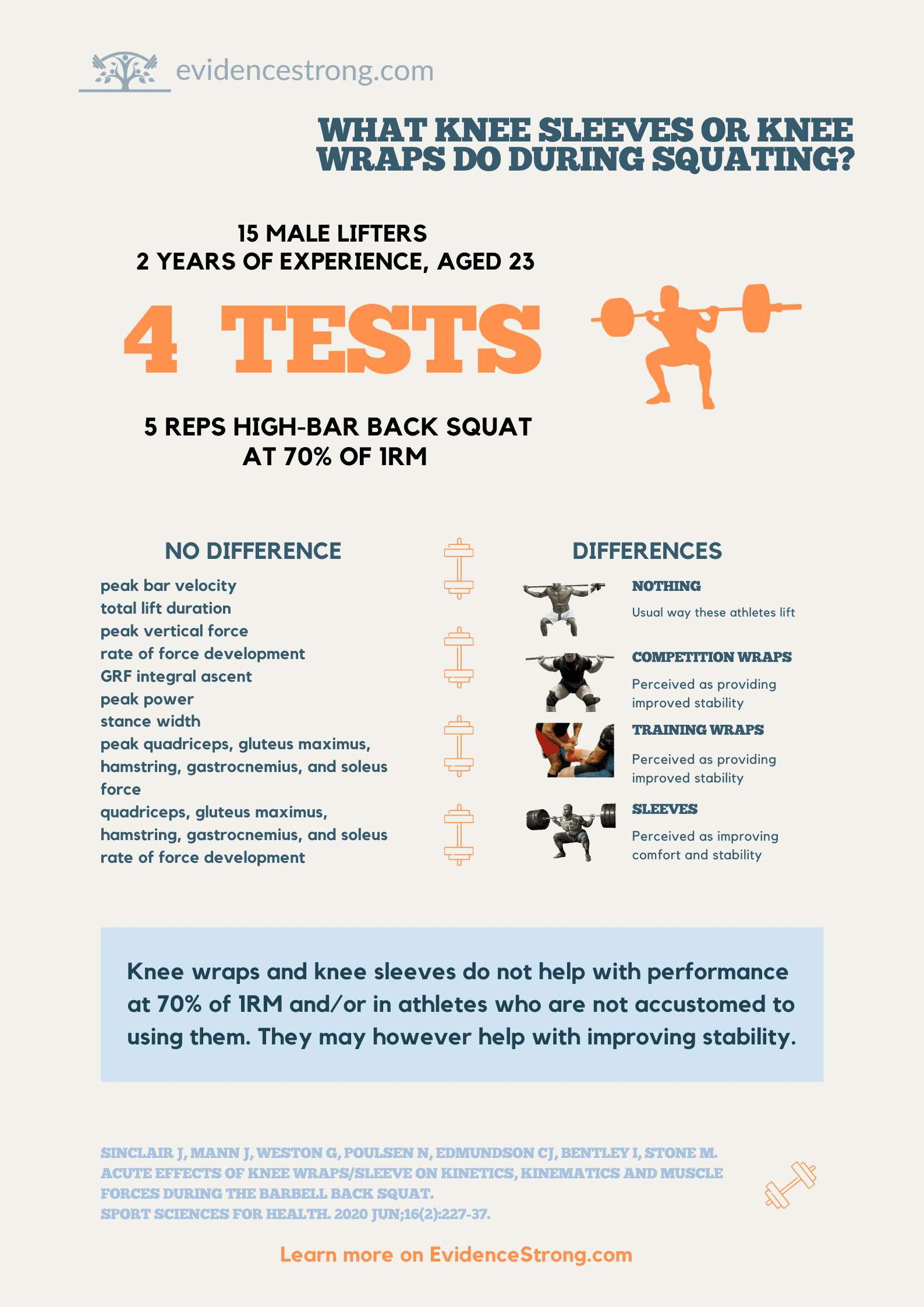Summary of a study looking at biomechanics and perceptions of stability and comfort in lifters who do squats in knee wraps or knee sleeves.
Who
15 male lifters with at least 2 years of experience aged 23 ± 3.5 years (height: 181.93 ± 7.25 cm; weight: 85.83 ± 17.10 kg; back squat 1RM: 122.62 ± 24.43 kg) (UK). Lifters were not accustomed to using knee wraps or sleeves.
Design
cross-over design: after warm-up, each person lifted 5 repetitions of high bar back squat at 70% in each condition in “counterbalanced order” (3 minutes rest).
Comp wraps
- liters wearing competition knee wraps
- 2-meters long, width 8 cm
Training wraps
- lifters wearing training knee wraps
- 2-meters long, width 8 cm
Sleeves
- lifters wearing Neoprene sleeves,
- 7mm thickness and 30cm length, 4 sizes: small, medium, large, extra-large
Nothing
- liters wearing nothing on the knee
Outcome measures
- perceived stability and comfort of the sleeves/wraps
- preferred condition to squat (nothing, knee wrap, knee sleeve)
- kinematics, GRF (ground reaction force)
Main results
Descent phase:
- vertical GRF integral was greater in Sleeve compared to the other conditions.
- bar displacement was greater in Nothing condition comapred to Comp and Training wraps.
- % duration of the descent phase was greater in the Sleeves, Comp and Training wraps conditions compared to the Nothing condition.
- also, % duration of the descent phase was the greater in the Comp wraps than in the Sleeves condition.
Ascent phase:
- duration of this phase (also % duration of ascent phase) was the longest in Nothing condition compared to the other conditions.
- Also, % duration of ascent phase was longer in Sleeves condition compared to the Comp wrap condition.
- quadriceps force integral was larger for the Nothing condition compared to the Comp wraps.
- gluteus maximus and hamstring integrals were larger for the Nothing condition compared to the Training wraps.
- gastrocnemius and soleus integrals were larger in the Nothing and Sleeves condition compared to the Comp wraps.
Knee:
- knee anterior translation was greater in the Nothing condition compared to Comp wraps.
- knee lateral translation was greater in the Nothing and Sleeves conditions compared to Comp and Training wraps.
- knee sagittal range of motion was larger in the Nothing condition compared to the Comp wraps, and Sleeves compared to Comp and Training wraps.
- knee coronal range of motion was larger in the Comp and Training wraps compared to the Nothing and Sleeves conditions.
- knee transverse range of motion was larger in the Comp and Training wraps conditions compared to the Nothing condition, and Training wraps compared to the Sleeves condition.
- Knee peak shear force was greater in the Nothing and Sleeves condition compared to the Comp wraps.
- peak knee adduction angle was larger in Comp and Training wraps compared to Nothing and Sleeves conditions.
- peak knee internal rotation was larger in the Comp and Training wraps conditions compared to the Nothing condition.
Hip:
- peak internal rotation was larger in the Comp and Training wraps compared to the Nothing and Sleeves conditions.
Ankle:
- peak dorsiflexion was larger in the Nothing and Sleeves conditions compared to the Comp wraps.
- peak eversion was larger in the Sleeves, Training and Comp wraps compared to the Nothing condition.
- ankle sagittal range of motion was larger in the Nothing condition compared to the Comp and Training wraps conditions, and Sleeves condition compared to the Comp wraps.
- coronal range of motion was larger in the Nothing condition compared to the Comp and Training wraps conditions.
No difference between conditions in:
- peak bar velocity (m/s)
- total lift duration (s), descent duration (s)
- peak vertical force (N/kg)
- rate of force development (N/kg/s)
- medial, posterior and vertical GRF integral ascent (N/kg s)
- medial and posterior GRF integral descent (N/kg s)
- peak power (W/kg)
- stance width (m)
- peak quadriceps force (N/kg), quadriceps integral descent (N/kg s), quadriceps rate of force development (N/kg/s)
- peak gluteus maximus force (N/kg), gluteus maximus integral descent (N/kg s), gluteus maximus rate of force development (N/kg/s)
- peak hamstring force (N/kg), hamstring integral descent (N/kg s), hamstring rate of force development (N/kg/s)
- peak gastrocnemius force (N/kg), gastrocnemius integral descent (N/kg s), gastrocnemius rate of force development (N/kg/s)
- peak soleus force (N/kg), soleus integral descent (N/kg s), soleus rate of force development (N/kg/s)
- knee shear force integral (N/kg s), knee shear force instantaneous load rate (N/kg/s)
- peak patellar tendon force (N/kg), patellar tendon force integral (N/kg s), patellar tendon force instantaneous load rate (N/kg/s), peak patellofemoral force (N/kg), patellofemoral force integral (N/kg s), patellofemoral force instantaneous load rate (N/kg/s), patellofemoral tendon stress (kPa/kg), patellofemoral stress integral (kPa/kg s), patellofemoral stress instantaneous load rate (kPa/kg/s)
- trunk (sagittal plane) peak flexion (°), trunk sagittal plane ROM (range of motion) (°)
- hip (sagittal plane) peak flexion (°) and ROM (°); hip (coronal plane) peak abduction (°) and ROM (°), hip (transverse plane) ROM (°)
- knee (sagittal plane) peak flexion (°)
- ankle (transverse plane) peak external rotation (°) and ROM (°)
Participants’ perceptions:
- Participants prefered Sleeves, as they improved comfort and stability.
- Both Competition and Training wraps reduced comfort but provided improved stability.
Take home message
Original article
Sinclair J, Mann J, Weston G, Poulsen N, Edmundson CJ, Bentley I, Stone M. Acute effects of knee wraps/sleeve on kinetics, kinematics and muscle forces during the barbell back squat. Sport Sciences for Health. 2020 Jun;16(2):227-37.
